镍钯合金粉多次氧化后在氢气氘气氛围多余热量实验
2021-09-10 22:43:12 来源:冷聚变世界 评论:0 点击:
本次实验拟观察镍钯合金在多次氧化后的多余热量,实验历时一个月,观察到了多余热量,可以验证高桥教授和STORMS博士的实验重复性,实验观察到的多余热量不大,不过与高桥教授的实验趋势吻合,温度特性相同。下一步需要改进配方,期望获得更大的稳定多余热量。
镍钯合金粉多次氧化后在氢气氘气氛围多余热量实验
Experiment of excess heat in hydrogen deuterium atmosphere after multiple oxidation of nickel palladium alloy powder
张航
Zhang hang
秋然实验室
Qiuran Laboratory715469127@qq.com
摘要:本次实验拟观察镍钯合金在多次氧化后的多余热量,实验历时一个月,观察到了多余热量,可以验证高桥教授和STORMS博士的实验重复性,实验观察到的多余热量不大,不过与高桥教授的实验趋势吻合,温度特性相同。下一步需要改进配方,期望获得更大的稳定多余热量。Zhang hang
秋然实验室
Qiuran Laboratory715469127@qq.com
Abstract: this experiment intends to observe the excess heat of nickel palladium alloy after multiple oxidation. The experiment lasted for one month, and the excess heat was observed, which can verify the repeatability of Professor Takahashi and Dr. storms. The excess heat observed in the experiment is small, but it is consistent with Professor Takahashi's experimental trend, and the temperature characteristics are the same. The next step is to improve the formula, hoping to obtain more stable excess heat.
关键词:金属,氧化,氢/氘气,多余热量
Key words: metal, oxidation, hydrogen / deuterium gas, excess heat
1、实验过程
1. Experimental process
1.1 量热计
1.1 calorimeter
秋然实验室的量热计构造和stroms博士的的基本相同。
The calorimeter structure of qiuran laboratory is basically the same as that of Dr. stroms.
量热计内腔尺寸200*200*800
Cavity size of calorimeter 200 * 200 * 800
用了200片40*40的热电元件贴附在内腔外表面
200 pieces of 40 * 40 thermoelectric elements are attached to the outer surface of the inner cavity
热电元件外侧是水冷片
Outside the thermoelectric element is a water cooling plate
循环水供水温度25℃
The temperature of circulating water supply is 25 ℃
循环水供水温度波动+-0.01℃
Temperature fluctuation of circulating water supply + - 0.01 ℃
空白试验数据图如下
The blank test data are as follows
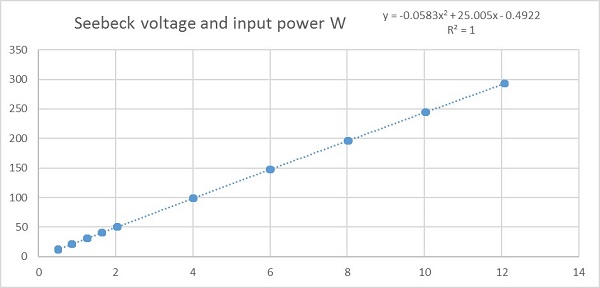
图1量热计空白实验数据图
Fig. 1 blank experimental data of calorimeter
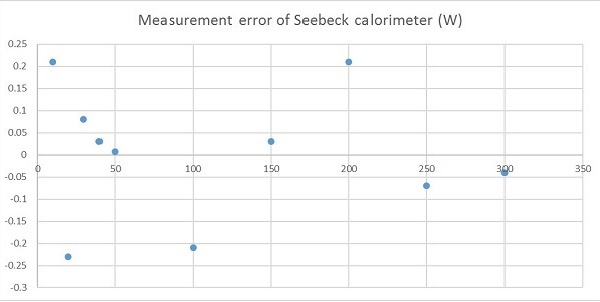
图2、塞贝克量热计误差
Figure 2. Seebeck calorimeter error

图2、塞贝克量热计误差
Figure 2. Seebeck calorimeter error
标准误差+-0.2瓦
Standard error + - 0.2W1.2 实验过程
1.2 experimental process
合金用镍粉和钯粉制备,将镍粉和钯粉混合后放入球磨机,进行机械合金化,分散剂用的是水,镍粉钯粉重量配比是200:5,球磨时间60小时,球磨后取出合金粉,干燥,装入容器。将容器放入量热计中。
The alloy is prepared with nickel powder and palladium powder. After mixing the nickel powder and palladium powder, it is put into a ball mill for mechanical alloying. The dispersant uses water, the weight ratio of nickel powder to palladium powder is 200:5, and the ball milling time is 60 hours. After ball milling, the alloy powder is taken out, dried and loaded into a container. Place the container in the calorimeter.
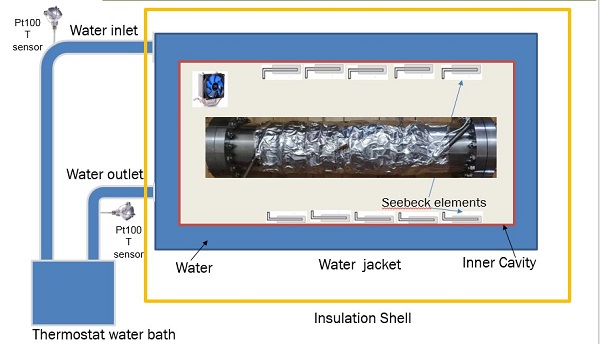
图3 实验装置系统图
Fig. 3 system diagram of experimental device
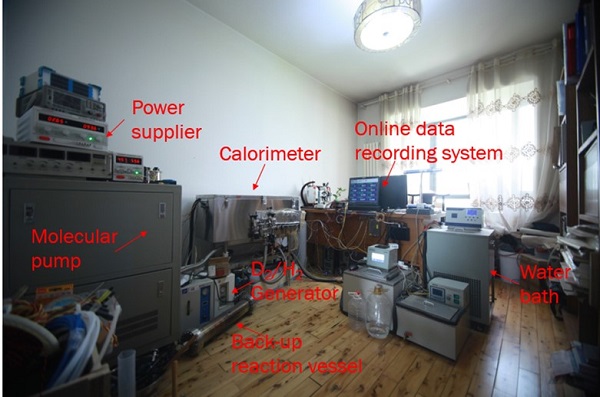

图4 实验装置照片
Fig. 4 photo of experimental device
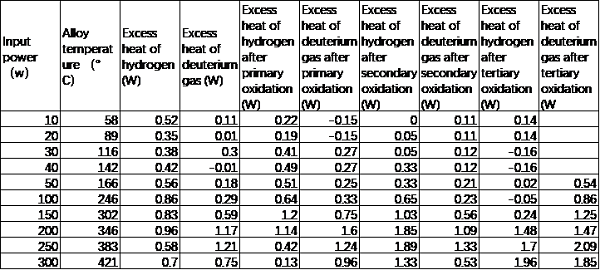

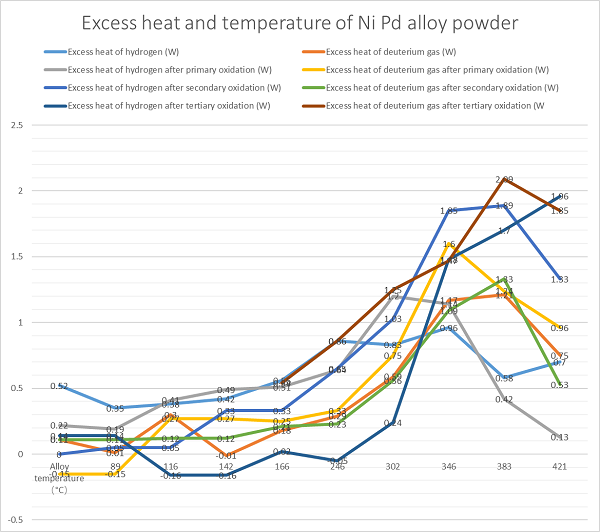
图5 多余热量功率与温度
Figure 5 excess heat power and temperature
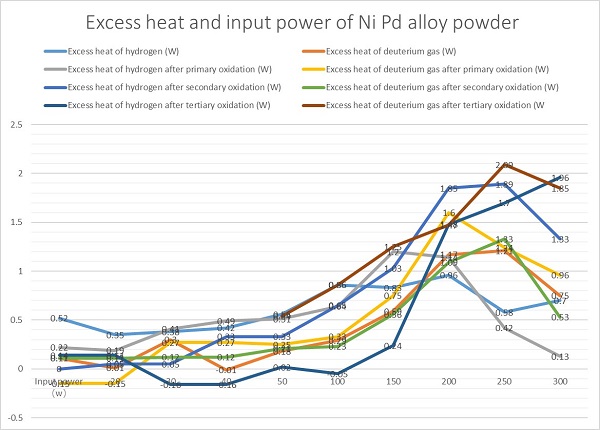
图6 多余热量功率与加热功率
Figure 6 excess heat power and heating power
5、 小结
5、Summary
5.1 在166° C以下,多余热量功率不明显
5.1 below 166 ° C, the excess heat power is not obvious
5.2 氢气与氘气多余热量功率基本相同
5.2 the excess heat power of hydrogen and deuterium is basically the same
5.3 多次氧化可以提高多余热量功率
5.3 multiple oxidation can increase excess heat power
5.4 实验历时一个月,200克材料,总的多余热量约1.2MJ
5.4 the experiment lasted for one month, 200 grams of material, and the total excess heat was about 1.2mj
5.5 下一步计划改进配方进行实验,期望取得大一些的多余热量功率。
5.5 in the next step, it is planned to improve the formula and carry out experiments, hoping to obtain larger excess heat power.
参考文献
Reference
1、Akito Takahashi, Masahiko Hasegawa, Yutaka Mori, Joji Hachisuka, Yuichi Furuyama Progress in Nano- - Metal Hydrogen Energy ,Talk at The ICCF23 web conference; June 9-11, 2021
2、Edmund Storms, United States ,The Nature of the D+D Fusion Reaction in Palladium and Nickel ,Talk prepared for ICCF-23, June 9-11, 2021
5、Summary
5.1 在166° C以下,多余热量功率不明显
5.1 below 166 ° C, the excess heat power is not obvious
5.2 氢气与氘气多余热量功率基本相同
5.2 the excess heat power of hydrogen and deuterium is basically the same
5.3 多次氧化可以提高多余热量功率
5.3 multiple oxidation can increase excess heat power
5.4 实验历时一个月,200克材料,总的多余热量约1.2MJ
5.4 the experiment lasted for one month, 200 grams of material, and the total excess heat was about 1.2mj
5.5 下一步计划改进配方进行实验,期望取得大一些的多余热量功率。
5.5 in the next step, it is planned to improve the formula and carry out experiments, hoping to obtain larger excess heat power.
参考文献
Reference
1、Akito Takahashi, Masahiko Hasegawa, Yutaka Mori, Joji Hachisuka, Yuichi Furuyama Progress in Nano- - Metal Hydrogen Energy ,Talk at The ICCF23 web conference; June 9-11, 2021
2、Edmund Storms, United States ,The Nature of the D+D Fusion Reaction in Palladium and Nickel ,Talk prepared for ICCF-23, June 9-11, 2021
分享到:
 收藏
收藏
评论排行
- ·黑光能源公司 BlackLight Power, In...(4294967281)
- ·冷聚变技术可以结束当前的雾霾天气吗?(13)
- ·布里渊能源技术公司的CECR技术简介(9)
- ·Defkalion公司的5千瓦Hyperion冷聚变反应堆(8)
- ·截止2014年国内外冷聚变研究现状(8)
- ·美军宣称已成功将海水直接转化为燃料(8)
- ·关于近期对E-CAT真实性质疑的问题(8)
- ·中核研究院成功复制镍氢冷核聚变装置E-CAT(7)
- ·美预言家预测人类在未来18个月内实现冷...(6)
- ·黑光能源公司宣布改变能源领域游戏规则...(6)
- ·镍氢电能(E-CAT)研究中心落户天津(6)
- ·工业热力公司公告称罗西起诉没有任何价值(6)
- ·空中客车公司对冷核聚变研发感兴趣(5)
- ·1升水能让汽车跑5000公里(4)
- ·冷聚变开拓者:马丁. 弗莱希曼 和 斯...(4)
- ·世界上第一台冷聚变装置E-CAT的研发历程(4)
- ·冷聚变是伪科学吗?(4)
- ·冷聚变将引发环保和新能源技术新的革命(4)
- ·德国EGM公司的水基燃料技术(4)
- ·英国国防部最新报告:冷聚变技术将来会...(4)
